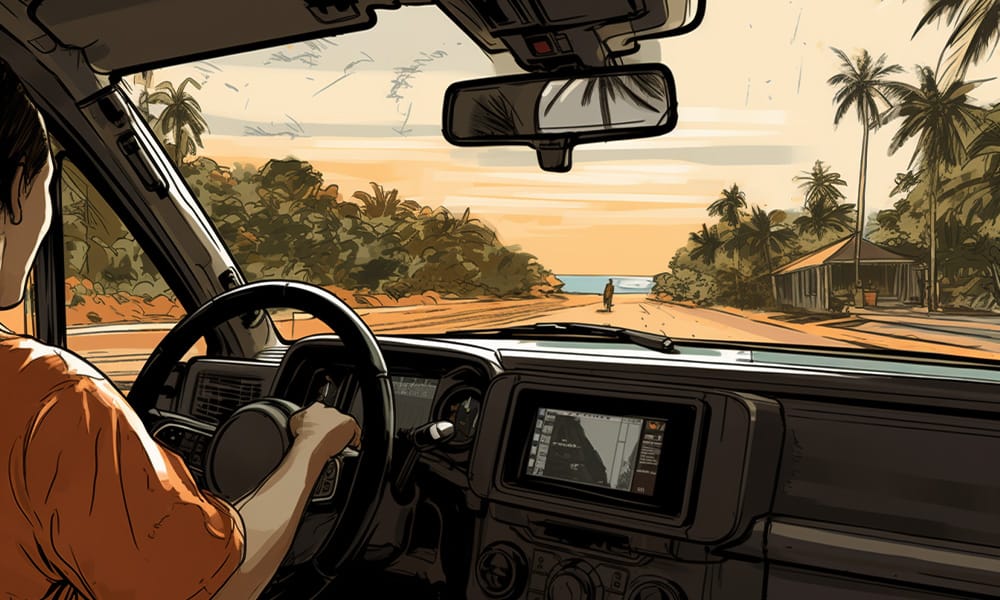We did it. My wife and I quit our jobs, U-hauled all of our belongings to my parent’s barn, rented out our little house, and moved to Costa Rica. We were about a week or two into our new tropical lives when we decided to get in our overly-expensive, not very nice, dated SUV and go for an adventure to a new beach. We navigated the main highway, hung a left onto a dirt road, and traveled in a cloud of dust toward the unknown.
After a few hundred yards, I eased the car to a halt, “What’s the deal with this?” I said to my wife, completely perplexed. There was a stream crossing the road. There was no way around it. There was no bridge. How can there be a stream in the road? We both got out of the car and looked at it. Can you drive through streams? We didn’t know. With a seemingly unpassable liquid roadblock between us and our adventure, we did the only thing we could. We turned around and went home.
Some things about driving in Costa Rica and driving in the United States are the same. The traffic patterns are generally the same. You drive on the same side of the road. But somethings about navigating the streets of Costa Rica, especially rural Costa Rica, are quite different.
Tico Addresses
When my wife landed a job at a non-profit in a beachside town in Costa Rica, we had a million questions. One of which was, what’s the address of the apartment that came with the job? What was the house number? The answer, there wasn’t one. Well then what was the name of the street? It didn’t have one.
Many years later, I forget what the exact address was, but I know it was more of story about the apartment location than what I considered a normal address. It was something like, the third house on the dirt road, after the left turn, on the second floor.
While I believe it’s different in San Jose, rural Costa Rica has few street names and no house numbers. My current address is – 500 meters north of Café del Pueblo, white house on the left. What’s funny about that address is nearly all of it is incorrect. For one, Café del Pueblo no longer exists.
That restaurant closed a few years ago and has been replaced at least once, maybe twice, by restaurants of different names. As for 500 meters north, we made that up. I don’t know how many meters we are from the main road, but I guarantee it’s not exactly 500. Next, our house isn’t white. It used to be a yellow that my wife picked out that was so light that it looked white. Later, she decided she preferred a green that was so light that it looked white. What is for sure correct is that our house is on the left.
Your Navigation System Works – Kind of
Upon arriving to start our new lives in Costa Rica, we were tasked with driving our newly purchased, terrible, old SUV from San Jose to a sleepy Guanacastecan beach town. Believe it or not, this was long enough ago that we didn’t have internet on our phones or a GPS unit in the car. We had been provided with a multi-page document that we printed out describing, in detail, how to get to where we would be living. It said things like turn left at the restaurant with the giant bull statue and bare right at the pizza place that looks like a castle.
These days, I navigate this tiny country like the rest of the world, by going where my phone tells me to. Sometimes this works out just peachy. Other times my phone recommends that I take a road that could only possibly be traversed by cows, or it tells me to turn onto a road that randomly has a gate with a huge lock on it or it says I’ll make it to my destination the quickest if I drive through a giant, aggressively flowing river. You never know what the road has in store for you.
Costa Rica is a land of adventure. You can repel down waterfalls, zipline through the sky, and explore forests echoing with the calls of howler monkeys, but be prepared, it could be an adventure just to reach your destination.
About the Author
Vincent Losasso, founder of Guanacaste Wildlife Monitoring, is a biologist who works with camera traps throughout Costa Rica. Learn more about his projects on facebook or instagram. You can also email him at: vincent@guanacastewildlifemonitoring.com








